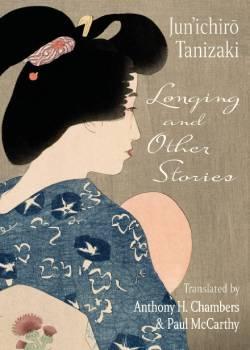Longing and Other Stories

By Tanizaki Junichiro
Columbia University Press (2022)
ISBN-13: 978-0231202152
Review by Laurence Green
I have always thought of Tanizaki Junichiro as the grandmaster of a very particular old-school charm within the wider gamut of Japanese literature. From door-stop landmarks like The Makioka Sisters, to smaller delicacies like Some Prefer Nettles or The Key, he conjures up a world lost to time, but at once on the cusp of transition. This Japan at the turn of the early twentieth century fluxes between East and West, the traditional and the modern, whilst serving up all the minutiae that make up everyday life. His characters feel real because they are often so impossibly mundane. The detail is invariably Dickensian in scope, and it is from these details that we inhabit Tanizaki’s world with a vividness that, while always in step to the command of the written word, has a visuality not unlike a camera recording.
And so, in his many portraits of Japanese life, served up via a new collection from esteemed Tanizaki translators Anthony H. Chambers and Paul McCarthy, we are invited to yet again spend time in a world that is half vintage sepia photograph, and half the vivid beating lifeblood of humanity. These three early tales all centre around and explore family bonds, and the latter in particular – ‘The Story of an Unhappy Mother’ - focuses on that perennial favourite of Japanese fiction through the ages: the tricky instance of the mother-in-law. What initially seems to be a darkly humorous take on the subject soon becomes far more morally complex in its sympathies. Tanizaki’s writing is never more steeped in the rituals and etiquette of the past than it is here, and yet the familial passions he deals with are timeless in their core.
The past few years have seen something of a mini-renaissance for Tanizaki translations into English, heralded by elegant editions of The Maids and Devils in Daylight (from W. W. Norton & Company) as well as the runaway success of A Cat, a Man, and Two Women as part of a wider trend in cat-related Japanese fiction proving to be the publishing equivalent of gold-dust. What is remarkable is that over half a century since his death, Tanizaki’s works are still being translated, like some newly mined secret mineral vein, and offered up to global audiences who delight in the vision of a Japan that is somehow familiar precisely because of the exoticism it presents - both spatially and temporally. As we move further from the origin of these stories in time, and as Japan itself shifts ever further from modernism to post-modernism to post-post-modernism, the world Tanizaki paints seems even more exquisite.
Indeed, Tanizaki’s great strength, as this slim collection of tales only reaffirms, is his versatility. Capable in adapting himself to a wider variety of literary forms and devices, the affability and skill of his prose mingles with the cornucopia of Japanese life, the stories contained here not only vintage vignettes of short fiction, but also candid documents of social history. These are not stories to gobble down in haste, and those looking for propulsive plotlines will be disappointed. Instead, like the most elegant of kaiseki multi-course menus, Tanizaki guides us towards an experience in which we savour, slowly, delicately, all he has to offer. Each page is dense with the sheer essence of his literary capacity and the longer we soak in it, the more it has to offer.

